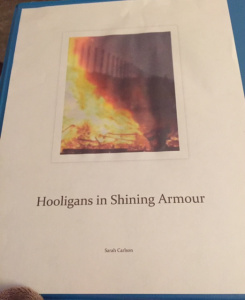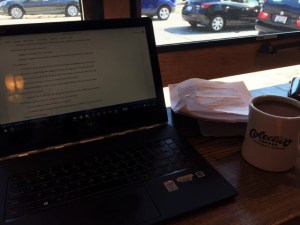Developmental edits can seem like an insurmountable mound of criticism. Rather than running from the challenge, prepare yourself and rise to the challenge. Try these suggestions from Sarah J. Carlson, author of Hooligans in Shining Armour.
Tackling structural or developmental edits: Free your mind
Developmental edits can be daunting, particularly if you may need to take characters or plot in new directions. My agent is challenging me to think differently about both my characters and my plot. I need to get out of my head and think differently. When you’ve been working on an MS for months (or years now, in my case), it can be hard to think differently about those characters that have been living in your brain for so long. Taking plot in a new direction can be such a challenge, because the path has become so ingrained.
One of my personal challenges for this re-write has to do with the way I structured the story. Hooligans in Shining Armour is first person dual POV. One of the things I need to work on is ensuring each character has their own unique external story arc in addition to their growing relationship. Per agent advice, I’m going to treat them as independent stories as much as possible, then weave them together.
Here’s what’s working for me as I try to free my mind and blow up this manuscript with another re-write.
- Time, time, time. I sent the last version to my agent at the end of July. I got it back about two weeks ago, which gave my brain almost a two month break. Much needed. During that time, I didn’t think about those characters at all. I worked on another WIP with radically different setting and characters. Now I’m refreshed and eager to get back to the manuscript in question , to explore my beloved characters again, and to detach myself from plot as it is currently written.
- Read the feedback…multiple times. The first time I read pages of feedback, it overwhelms my brain. Impossible, it screams. Or it tries to argue. So I read it. Set it aside. Read it the next day. Perhaps take another day, then read again. In the interim, my brain my start working on things, saying “well you could do this” or “she has a point there.” Etc. But I need several days to process it, and I need to read it multiple times for all the pieces to come together. Then I highlight it, pull it apart, copy/paste to connect ideas.
 3. Create a new playlist. I create playlists for each manuscript I write because it helps get my brain in gear to capture characters and emotion. I’ve been using the same one for Hooligans for the past two years, so to change my brain, I created a new one. Some of the same songs, yes, but I got rid of a bunch and added some new ones.
3. Create a new playlist. I create playlists for each manuscript I write because it helps get my brain in gear to capture characters and emotion. I’ve been using the same one for Hooligans for the past two years, so to change my brain, I created a new one. Some of the same songs, yes, but I got rid of a bunch and added some new ones.4. Organize my life. And by that, I mean I created a binder with tabs for research, agent feedback, and–perhaps most importantly–separate tabs for each POV character so my brain thinks of them as separate, yet connected, stories.
5. Get out of my space. My brain works differently when I’m not in my house distracted by chores, dogs, husband :P. I have a favorite coffee shop I like to escape to that allows my brain to free itself. Even on the drive over (while listening to my new playlist), my brain is working.
6. Free write. I’m taking the bits of feedback I need to process and just freewriting my thoughts on them. Sometimes I start writing new scene or dialogue. It’s amazing what that unlocks in my subconscious. The direction my brain goes often surprises me. Even on the drive over (while listening to my new playlist), my subconscious starts unlocking pieces and finding new potential paths through.
7. Go back and read the feedback again. This time I tear it apart, try to pick out major trends, lump ideas together, select what’s an easily actionable item versus what do I need to do more free writing on. The feedback looks and feels different now, and I pick up on things I missed the first times I read through it. Then more free writing. I start firing questions at my agent or critique partner to see what they think.
These are a few of the steps I take to get my brain primed for the hard work of tackling intense structural or developmental edits. Then I’m ready to dig in and do the hard thinking. I’m so excited to delve in and explore these characters in new ways.
Writer friends, what first steps do you take to prime your brain for major structural or developmental edits? To prepare yourself for a huge re-write?




